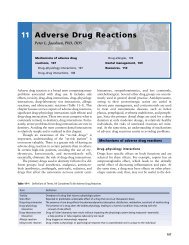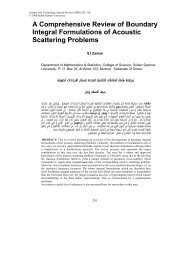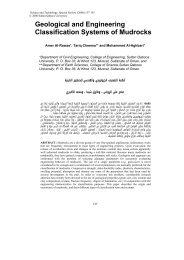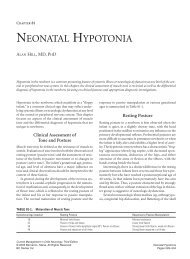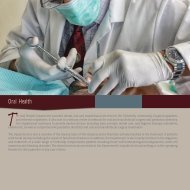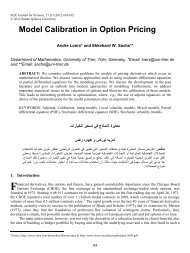Ch05: Red and White Lesions of the Oral Mucosa
Ch05: Red and White Lesions of the Oral Mucosa
Ch05: Red and White Lesions of the Oral Mucosa
You also want an ePaper? Increase the reach of your titles
YUMPU automatically turns print PDFs into web optimized ePapers that Google loves.
<strong>Red</strong> <strong>and</strong> <strong>White</strong> <strong>Lesions</strong> <strong>of</strong> <strong>the</strong> <strong>Oral</strong> <strong>Mucosa</strong> 113<br />
FIGURE 5-37 Symptomatic gingival lesion <strong>of</strong> systemic lupus ery<strong>the</strong>matosus.<br />
The lesion is composed <strong>of</strong> <strong>the</strong> characteristic elements <strong>of</strong> a lupus reaction,<br />
including areas <strong>of</strong> ery<strong>the</strong>ma, ulceration, <strong>and</strong> hyperkeratosis (leukoplakia).<br />
Discoid lupus ery<strong>the</strong>matosus (DLE) is a relatively common<br />
disease <strong>and</strong> occurs predominantly in females in <strong>the</strong> third<br />
or fourth decade <strong>of</strong> life. 242 DLE can present in both localized<br />
<strong>and</strong> disseminated forms <strong>and</strong> is also called chronic cutaneous<br />
lupus (CCL). DLE is confined to <strong>the</strong> skin <strong>and</strong> oral mucous<br />
membranes <strong>and</strong> has a better prognosis than SLE. 20 Typical<br />
cutaneous lesions appear as red <strong>and</strong> somewhat scaly patches<br />
that favor sun-exposed areas such as <strong>the</strong> face, chest, back, <strong>and</strong><br />
extremities. These lesions characteristically exp<strong>and</strong> by peripheral<br />
extension <strong>and</strong> are usually disk-shaped. The oral lesions can<br />
occur in <strong>the</strong> absence <strong>of</strong> skin lesions, but <strong>the</strong>re is a strong association<br />
between <strong>the</strong> two. As <strong>the</strong> lesions exp<strong>and</strong> peripherally,<br />
<strong>the</strong>re is central atrophy, scar formation, <strong>and</strong> occasional loss <strong>of</strong><br />
surface pigmentation. <strong>Lesions</strong> <strong>of</strong>ten heal in one area only to<br />
occur in a different area later.<br />
The oral mucosal lesions <strong>of</strong> DLE frequently resemble reticular<br />
or erosive lichen planus. The primary locations for <strong>the</strong>se<br />
lesions include <strong>the</strong> buccal mucosa, palate, tongue, <strong>and</strong> vermilion<br />
border <strong>of</strong> <strong>the</strong> lips. Unlike lichen planus, <strong>the</strong> distribution<br />
<strong>of</strong> DLE lesions is usually asymmetric, <strong>and</strong> <strong>the</strong> peripheral<br />
striae are much more subtle (Figure 5-39). The lesions may be<br />
atrophic, ery<strong>the</strong>matous, <strong>and</strong>/or ulcerated <strong>and</strong> are <strong>of</strong>ten<br />
painful. Hyperkeratotic lichen planus–like plaques are probably<br />
twice as common in patients with CCL as compared to<br />
patients with SLE. 243,244 The oral lesions <strong>of</strong> DLE are markedly<br />
variable <strong>and</strong> can also simulate leukoplakia. Therefore, <strong>the</strong><br />
diagnosis must be based not only on <strong>the</strong> clinical appearance<br />
<strong>of</strong> <strong>the</strong> lesions but also on <strong>the</strong> coexistence <strong>of</strong> skin lesions <strong>and</strong><br />
on <strong>the</strong> results <strong>of</strong> both histologic examination <strong>and</strong> direct<br />
immun<strong>of</strong>luorescence testing. Despite <strong>the</strong>ir similar clinical features,<br />
lichen planus <strong>and</strong> lupus ery<strong>the</strong>matosus yield markedly<br />
different immun<strong>of</strong>luorescent findings. Some authors 245<br />
believe that <strong>the</strong> histology <strong>of</strong> oral lupus ery<strong>the</strong>matosus is characteristic<br />
enough to provide a definitive diagnosis at <strong>the</strong> level<br />
<strong>of</strong> light microscopy, but most feel that <strong>the</strong> diagnostic st<strong>and</strong>ard<br />
must involve direct immun<strong>of</strong>luorescence. Importantly, lesions<br />
FIGURE 5-38 Lupus lesions frequently appear lichenoid but may be<br />
nonspecific <strong>and</strong> resemble leukoplakia.<br />
with clinical <strong>and</strong> immun<strong>of</strong>luorescent features <strong>of</strong> both lichen<br />
planus <strong>and</strong> lupus ery<strong>the</strong>matosus have also been described<br />
(overlap syndrome). 244<br />
Histopathologic Features<br />
The histopathologic changes <strong>of</strong> oral lupus consist <strong>of</strong> hyperorthokeratosis<br />
with keratotic plugs, atrophy <strong>of</strong> <strong>the</strong> rete ridges,<br />
<strong>and</strong> (most especially) liquefactive degeneration <strong>of</strong> <strong>the</strong> basal cell<br />
layer. Edema <strong>of</strong> <strong>the</strong> superficial lamina propria is also quite<br />
prominent. Most <strong>of</strong> <strong>the</strong> time, lupus patients lack <strong>the</strong> b<strong>and</strong>like<br />
leukocytic inflammatory infiltrate seen in patients with lichen<br />
planus. Immediately subjacent to <strong>the</strong> surface epi<strong>the</strong>lium is a<br />
b<strong>and</strong> <strong>of</strong> PAS-positive material, <strong>and</strong> frequently <strong>the</strong>re is a pronounced<br />
vasculitis in both superficial <strong>and</strong> deep connective tissue.<br />
Ano<strong>the</strong>r important finding in lupus is that direct<br />
immun<strong>of</strong>luorescence testing <strong>of</strong> lesional tissue shows <strong>the</strong> deposition<br />
<strong>of</strong> various immunoglobulins <strong>and</strong> C3 in a granular b<strong>and</strong><br />
FIGURE 5-39 Lupus lesions are common on <strong>the</strong> lip. Unlike lichen<br />
planus, lupus lesions are usually asymmetric in distribution, <strong>and</strong> <strong>the</strong> peripheral<br />
striae are much more subtle.






